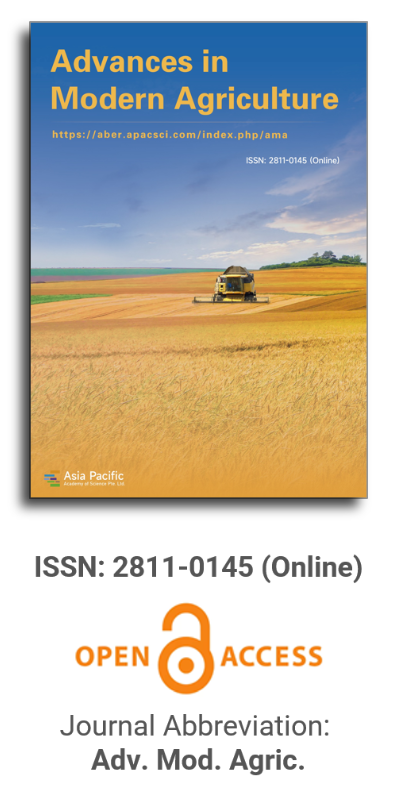


The influence of slope exposure on the yield characteristics of winter wheat and spring barley in the Oka River basin, Russia
Vol 5, Issue 1, 2024
VIEWS - 3122 (Abstract)
Download PDF
Abstract
We studied the relationship of the yield of winter wheat and spring barley with slope exposure components in the west of the Oka River basin. The size of the study area was 250 km by 360 km. The yield characteristics included the maximal yield obtained when applying the optimal dose of fertilizers, the yield without applying fertilizers (control), and the maximal addition to yield, that is, their difference. The addition is shown to be most sensitive to climatic factors. For wheat, the addition increased on the warmer southwestern slopes, and for barley—on the wetter north-eastern slopes. The high sensitivity of the addition of barley to moisture is shown using its comparison with climatic water deficit. To compare slopes by the energy of incident solar radiation, we used the slope insolation in energy units. Although the difference in energy between the southwest and northeast slopes was only 2.2%, wheat addition on these slopes varied by more than a factor of two. The reasons for this are discussed. The results obtained show that when choosing locations for crop areas, it is advisable to take into account the exposure of the slopes.
Keywords
References
- Alvarez R, Grigera S. Analysis of Soil Fertility and Management Effects on Yields of Wheat and Corn in the Rolling Pampa of Argentina. Journal of Agronomy and Crop Science. 2005, 191(5): 321-329. doi: 10.1111/j.1439-037x.2005.00143.x
- Lobell DB, Field CB. Global scale climate–crop yield relationships and the impacts of recent warming. Environmental Research Letters. 2007, 2(1): 014002. doi: 10.1088/1748-9326/2/1/014002
- Ferrara RM, Trevisiol P, Acutis M, et al. Topographic impacts on wheat yields under climate change: two contrasted case studies in Europe. Theoretical and Applied Climatology. 2010, 99: 53–65.
- Lobell DB, Burke MB. Why are agricultural impacts of climate change so uncertain? The importance of temperature relative to precipitation. Environmental Research Letters. 2008, 3(3): 034007. doi: 10.1088/1748-9326/3/3/034007
- Shary PA, Rukhovich OV, Sharaya LS. Analytical and Cartographic Predictive Modeling of Arable Land Productivity. Novel Methods for Monitoring and Managing Land and Water Resources in Siberia. Published online November 15, 2015: 489-502. doi: 10.1007/978-3-319-24409-9_21
- Shary PA, Sharaya LS, Rukhovich OV. Model-Based Forecasting Winter Wheat Yields Using Landscape and Climate Data. Landscape Modelling and Decision Support. Published online 2020: 383-396. doi: 10.1007/978-3-030-37421-1_20
- Schlenker W, Roberts MJ. Nonlinear temperature effects indicate severe damages to U.S. crop yields under climate change. Proceedings of the National Academy of Sciences. 2009, 106(37): 15594-15598. doi: 10.1073/pnas.0906865106
- Lobell DB, Schlenker W, Costa-Roberts J. Climate Trends and Global Crop Production Since 1980. Science. 2011, 333(6042): 616-620. doi: 10.1126/science.1204531
- Walley F, Pennock D, Solohub M, et al. Spring wheat (Triticum aestivum) yield and grain protein responses to N fertilizer in topographically defined landscape positions. Canadian Journal of Soil Science. 2001, 81(4): 505-514. doi: 10.4141/s00-036
- Basso B, Cammarano D, Chen D, et al. Landscape position and precipitation effects on spatial variability of wheat yield and grain protein in Southern Italy. Journal of Agronomy and Crop Science. 2009, 195: 301–312.
- Yang C, Peterson CL, Shropshire GJ, Otawa T. Spatial variability of field topography and wheat yield in the Palouse region of the Pacific northwest. Transactions of the American Society of Agricultural Engineers. 1998, 41: 17–27.
- Si BC, Farrell RE. Scale‐Dependent Relationship between Wheat Yield and Topographic Indices. Soil Science Society of America Journal. 2004, 68(2): 577-587. doi: 10.2136/sssaj2004.5770
- Xu Y, Yang B, Liu G, et al. Topographic differentiation simulation of crop yield and soil and water loss on the Loess Plateau. Journal of Geographical Sciences. 2009, 19(3): 331-339. doi: 10.1007/s11442-009-0331-6
- Persson A, Pilesjö P, Eklundh L. Spatial Influence of Topographical Factors on Yield of Potato (Solanum tuberosum L.) in Central Sweden. Precision Agriculture. 2005, 6(4): 341-357. doi: 10.1007/s11119-005-2323-6
- Jankauskas B, Jankauskienė G, Fullen MA. Relationships between soil organic matter content and soil erosion severity in Albeluvisols of the Žemaičiai Uplands. Ecologija. 2007, 53: 21–28.
- Wilkens P, Singh U. A code-level analysis for temperature effects in the CERES models. In: White JW (editor). Modeling Temperature Response in Wheat and Maize. Proceedings of a workshop, CIMMYT, El Batán, Mexico, 23–25 April 2001. pp. 1–7.
- Basso B, Liu L, Ritchie JT. A comprehensive review of the CERES-Wheat, -Maize and -Rice models’ performance. Advances in Agronomy. 2016, 136: 27–132.
- Wang Z, Ye L, Jiang J, et al. Review of application of EPIC crop growth model. Ecological Modelling. 2022, 467: 109952. doi: 10.1016/j.ecolmodel.2022.109952
- Shary PA, Smirnov NS. Mechanisms of the effects of solar radiation and terrain anisotropy on the vegetation of dark conifer forests in the Pechora-Ilych state biosphere reserve. Russian Journal of Ecology. 2013, 44(1): 9-17. doi: 10.1134/s1067413613010116
- Shary PA. Environmental Variables in Predictive Soil Mapping: A Review. Eurasian Soil Science. 2023, 56(3): 247-259. doi: 10.1134/s1064229322602384
- Lobell DB, Burke MB. On the use of statistical models to predict crop yield responses to climate change. Agricultural and Forest Meteorology. 2010, 150(11): 1443-1452. doi: 10.1016/j.agrformet.2010.07.008
- Pasquel D, Roux S, Richetti J, et al. A review of methods to evaluate crop model performance at multiple and changing spatial scales. Precision Agriculture. 2022, 23(4): 1489-1513. doi: 10.1007/s11119-022-09885-4
- Lobell DB, Ortiz‐Monasterio JI. Impacts of Day Versus Night Temperatures on Spring Wheat Yields: A Comparison of Empirical and CERES Model Predictions in Three Locations. Agronomy Journal. 2007, 99(2): 469-477. doi: 10.2134/agronj2006.0209
- Shary PA, Sharaya LS, Mitusov AV. Fundamental quantitative methods of land surface analysis. Geoderma. 2002, 107(1-2): 1-32. doi: 10.1016/s0016-7061(01)00136-7
- Sychev VG, Rukhovich OV, Romanenkov VA, et al. Case studies on developing a single systematized data base of field experiments of Agrochimsluzhba and geonetwork “Agrogeos” (Russian). Problems of Agrochemistry and Ecology. 2008, 3: 35–38.
- Rodriguez E, Morris CS, Belz JE, et al. An assessment of the SRTM topographic products. Technical Report JPL D-31639. Pasadena, California: Jet Propulsion Laboratory. 2005, 143.
- Beers TW, Dress PE, Wensel LC. Aspect transformation in site productivity research. Journal of Forestry. 1966, 64: 691–692.
- Lutz JA, van Wagtendonk JW, Franklin JF. Climatic water deficit, tree species ranges, and climate change in Yosemite National Park. Journal of Biogeography. 2010, 37(5): 936-950. doi: 10.1111/j.1365-2699.2009.02268.x
- Thornthwaite CW. An Approach toward a Rational Classification of Climate. Geographical Review. 1948, 38(1): 55. doi: 10.2307/210739
- Budyko MI. Thermal Balance of Land Surface (Russian). Leningrad: Hydrometeoizdat. 1956.
- Brutsaert W. Evaporation into the Atmosphere. Theory, History and Applications. London: D. Reidel Publishing Company. 1982.
- Hwang T, Song C, Vose JM, et al. Topography-mediated controls on local vegetation phenology estimated from MODIS vegetation index. Landscape Ecology. 2011, 26(4): 541-556. doi: 10.1007/s10980-011-9580-8
- Beckage B, Osborne B, Pucko C, et al. A rapid upward shift of a forest ecotone during 40 years of warming in the Green Mountains of Vermont. Proc. Nation. Acad. Sci. 2008, 105: 4197–4202.
Supporting Agencies
Copyright (c) 2024 P. A. Shary, L. S. Sharaya, O. V. Rukhovich
License URL: https://creativecommons.org/licenses/by/4.0/

This site is licensed under a Creative Commons Attribution 4.0 International License (CC BY 4.0).

Prof. Zhengjun Qiu
Zhejiang University, China

Cheng Sun
Academician of World Academy of Productivity Science; Executive Chairman, World Confederation of Productivity Science China Chapter, China
Indexing & Archiving
In the realm of modern agriculture, the integration of cutting-edge technologies is revolutionizing the way we approach sustainable farming practices. A recent study published in Advances in Modern Agriculture titled "Classification of cotton water stress using convolutional neural networks and UAV-based RGB imagery" has garnered significant attention for its innovative approach to precision irrigation management. Conducted by researchers from Institute of Data Science and the AgriLife Research and Extension Center of Texas A&M University (authors's information is below). This study introduces a novel method for classifying cotton water stress using unmanned aerial vehicles (UAVs) and convolutional neural networks (CNNs), offering a powerful solution for optimizing water use in agriculture.
Modern agricultural technology is evolving rapidly, with scientists collaborating with leading agricultural enterprises to develop intelligent management practices. These practices utilize advanced systems that provide tailored fertilization and treatment options for large-scale land management.
This journal values human initiative and intelligence, and the employment of AI technologies to write papers that replace the human mind is expressly prohibited. When there is a suspicious submission that uses AI tools to quickly piece together and generate research results, the editorial board of the journal will reject the article, and all journals under the publisher's umbrella will prohibit all authors from submitting their articles.
Readers and authors are asked to exercise caution and strictly adhere to the journal's policy regarding the usage of Artificial Intelligence Generated Content (AIGC) tools.
Asia Pacific Academy of Science Pte. Ltd. (APACSCI) specializes in international journal publishing. APACSCI adopts the open access publishing model and provides an important communication bridge for academic groups whose interest fields include engineering, technology, medicine, computer, mathematics, agriculture and forestry, and environment.



.jpg)
.jpg)

.jpg)
